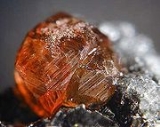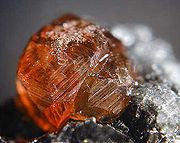
Almandine
Encyclopedia
Almandine also known incorrectly as almandite, is a species of mineral belonging to the garnet
Group. The name is a corruption of alabandicus, which is the name applied by Pliny the Elder
to a stone found or worked at Alabanda, a town in Caria in Asia Minor
. Almandine is an iron alumina garnet, of deep red color, inclining to purple. It is frequently cut with a convex face, or en cabochon
, and is then known as carbuncle
. Viewed through the spectroscope in a strong light, it generally shows three characteristic absorption bands.
Almandine is one end-member
of a mineral solid solution
series, with the other end member being the garnet pyrope
. The almandine crystal formula is: Fe3Al2(SiO4)3. Magnesium
substitutes for the iron
with increasingly pyrope-rich composition.
Almandine, Fe2+3Al2Si3O12, is the ferrous iron end member of the class of garnet minerals representing an important group of rock-forming silicates, which are the main constituents of the Earth's crust
, upper mantle and transition zone
. Almandine crystallizes in the cubic space group
Iad, with unit-cell parameter a ≈ 11.512 Å at 100 K.
Almandine is antiferromagnet with the Néel temperature
of 7.5 K. It contains two equivalent magnetic sublattices
 Almandine occurs rather abundantly in the gem-gravels of Sri Lanka
Almandine occurs rather abundantly in the gem-gravels of Sri Lanka
, whence it has sometimes been called Ceylon-ruby. When the color inclines to a violet tint, the stone is often called Syrian garnet, a name said to be taken from Syriam, an ancient town of Pegu. Large deposits of fine almandine-garnets were found, some years ago, in the Northern Territory of Australia
, and were at first taken for rubies and thus they were known in trade for some time afterwards as Australian rubies.
Almandine is widely distributed. Fine rhombic dodecahedra occur in the schist
ose rocks of the Zillertal
, in Tyrol, and are sometimes cut and polished. An almandine in which the ferrous oxide is replaced partly by magnesia is found at Luisenfeld in German East Africa. In the United States
there are many localities which yield almandine. Fine crystals of almandine embedded in mica
-schist occur near Fort Wrangell in Alaska
. The coarse varieties of almandine are often crushed for use as an abrasive
agent.
Garnet
The garnet group includes a group of minerals that have been used since the Bronze Age as gemstones and abrasives. The name "garnet" may come from either the Middle English word gernet meaning 'dark red', or the Latin granatus , possibly a reference to the Punica granatum , a plant with red seeds...
Group. The name is a corruption of alabandicus, which is the name applied by Pliny the Elder
Pliny the Elder
Gaius Plinius Secundus , better known as Pliny the Elder, was a Roman author, naturalist, and natural philosopher, as well as naval and army commander of the early Roman Empire, and personal friend of the emperor Vespasian...
to a stone found or worked at Alabanda, a town in Caria in Asia Minor
Asia Minor
Asia Minor is a geographical location at the westernmost protrusion of Asia, also called Anatolia, and corresponds to the western two thirds of the Asian part of Turkey...
. Almandine is an iron alumina garnet, of deep red color, inclining to purple. It is frequently cut with a convex face, or en cabochon
Cabochon
A cabochon , from the Middle French caboche , is a gemstone which has been shaped and polished as opposed to faceted. The resulting form is usually a convex top with a flat bottom. Cutting en cabochon is usually applied to opaque gems, while faceting is usually applied to transparent stones...
, and is then known as carbuncle
Carbuncle (gemstone)
A carbuncle is an archaic name given to any red cabochon cut gemstone. The name applied particularly to red garnet. The word occurs in four places in most English translations of the Bible...
. Viewed through the spectroscope in a strong light, it generally shows three characteristic absorption bands.
Almandine is one end-member
Endmember (mineralogy)
An endmember in mineralogy is a mineral that is at the extreme end of a mineral series in terms of purity. Minerals often can be described as solid solutions with varying compositions of some chemical elements, rather than as substances with an exact chemical formula...
of a mineral solid solution
Solid solution
A solid solution is a solid-state solution of one or more solutes in a solvent. Such a mixture is considered a solution rather than a compound when the crystal structure of the solvent remains unchanged by addition of the solutes, and when the mixture remains in a single homogeneous phase...
series, with the other end member being the garnet pyrope
Pyrope
The mineral pyrope is a member of the garnet group. Pyrope is the only member of the garnet family to always display red colouration in natural samples, and it is from this characteristic that it gets its name: from the Greek for fire and eye. Despite being less common than most garnets, it is a...
. The almandine crystal formula is: Fe3Al2(SiO4)3. Magnesium
Magnesium
Magnesium is a chemical element with the symbol Mg, atomic number 12, and common oxidation number +2. It is an alkaline earth metal and the eighth most abundant element in the Earth's crust and ninth in the known universe as a whole...
substitutes for the iron
Iron
Iron is a chemical element with the symbol Fe and atomic number 26. It is a metal in the first transition series. It is the most common element forming the planet Earth as a whole, forming much of Earth's outer and inner core. It is the fourth most common element in the Earth's crust...
with increasingly pyrope-rich composition.
Almandine, Fe2+3Al2Si3O12, is the ferrous iron end member of the class of garnet minerals representing an important group of rock-forming silicates, which are the main constituents of the Earth's crust
Crust (geology)
In geology, the crust is the outermost solid shell of a rocky planet or natural satellite, which is chemically distinct from the underlying mantle...
, upper mantle and transition zone
Transition zone
The transition zone is part of the Earth’s mantle, and is located between the lower mantle and the upper mantle, between a depth of 410 and 660 km...
. Almandine crystallizes in the cubic space group
Space group
In mathematics and geometry, a space group is a symmetry group, usually for three dimensions, that divides space into discrete repeatable domains.In three dimensions, there are 219 unique types, or counted as 230 if chiral copies are considered distinct...
Iad, with unit-cell parameter a ≈ 11.512 Å at 100 K.
Almandine is antiferromagnet with the Néel temperature
Néel temperature
The Néel temperature or magnetic ordering temperature , TN, is the temperature above which an antiferromagnetic material becomes paramagnetic—that is, the thermal energy becomes large enough to destroy the macroscopic magnetic ordering within the material....
of 7.5 K. It contains two equivalent magnetic sublattices
Occurrence

Sri Lanka
Sri Lanka, officially the Democratic Socialist Republic of Sri Lanka is a country off the southern coast of the Indian subcontinent. Known until 1972 as Ceylon , Sri Lanka is an island surrounded by the Indian Ocean, the Gulf of Mannar and the Palk Strait, and lies in the vicinity of India and the...
, whence it has sometimes been called Ceylon-ruby. When the color inclines to a violet tint, the stone is often called Syrian garnet, a name said to be taken from Syriam, an ancient town of Pegu. Large deposits of fine almandine-garnets were found, some years ago, in the Northern Territory of Australia
Australia
Australia , officially the Commonwealth of Australia, is a country in the Southern Hemisphere comprising the mainland of the Australian continent, the island of Tasmania, and numerous smaller islands in the Indian and Pacific Oceans. It is the world's sixth-largest country by total area...
, and were at first taken for rubies and thus they were known in trade for some time afterwards as Australian rubies.
Almandine is widely distributed. Fine rhombic dodecahedra occur in the schist
Schist
The schists constitute a group of medium-grade metamorphic rocks, chiefly notable for the preponderance of lamellar minerals such as micas, chlorite, talc, hornblende, graphite, and others. Quartz often occurs in drawn-out grains to such an extent that a particular form called quartz schist is...
ose rocks of the Zillertal
Zillertal
The Zillertal is the biggest valley branching off the Inn valley in Tyrol, Austria drained by the river Ziller. It is surrounded by the strongly glaciated Zillertal Alps to the south and east, the lower grass peaks of the Kitzbühel Alps to the east and Tux Alps to the west...
, in Tyrol, and are sometimes cut and polished. An almandine in which the ferrous oxide is replaced partly by magnesia is found at Luisenfeld in German East Africa. In the United States
United States
The United States of America is a federal constitutional republic comprising fifty states and a federal district...
there are many localities which yield almandine. Fine crystals of almandine embedded in mica
Mica
The mica group of sheet silicate minerals includes several closely related materials having highly perfect basal cleavage. All are monoclinic, with a tendency towards pseudohexagonal crystals, and are similar in chemical composition...
-schist occur near Fort Wrangell in Alaska
Alaska
Alaska is the largest state in the United States by area. It is situated in the northwest extremity of the North American continent, with Canada to the east, the Arctic Ocean to the north, and the Pacific Ocean to the west and south, with Russia further west across the Bering Strait...
. The coarse varieties of almandine are often crushed for use as an abrasive
Abrasive
An abrasive is a material, often a mineral, that is used to shape or finish a workpiece through rubbing which leads to part of the workpiece being worn away...
agent.

